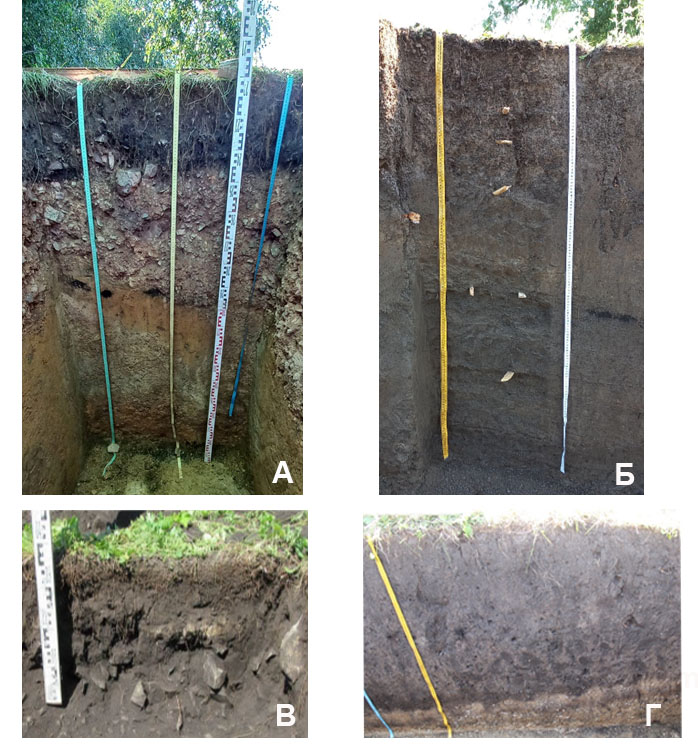Почвенно-геохимическое изучение черноземов и культурных слоев (возрастом от палеолита до средневековья) поселений горнорудного Урала
DOI:
https://doi.org/10.31251/pos.v8i2.290Ключевые слова:
поллютанты; органическое вещество почв; природное и техногенное накопление элементов; педологические, микробиологические и геохимические свойства; химические элементы; археологические находки.Аннотация
Цель исследования. Дать характеристику почвенно-геохимических свойств черноземов и культурных слоев (КС) восьми поселений возрастом от палеолита до средневековья, расположенных на территории горнорудного Южного Урала; расширить информацию о содержании тяжелых металлов в почвах региональной геохимической аномалии на основе детального их определения в профиле в каждом последующем слое 5 см до материнской породы.
Методология. Совместно с археологами изучены почвы и КС восьми разновозрастных поселений (136–2,5 тыс. лет), расположенных вдоль склона гор Южного Урала. Объекты находятся на террасах малых рек бассейна р. Урал, используются как умеренно выпасаемые пастбища, а участок Теляшево-4 (3,9–3,45 тысяч лет назад) (тыс. л. н.) – как пашня. Пробы почв и КС объектов отобраны последовательно из каждого 5-см слоя до почвообразующей породы; в слое 0–30 см образцы взяты в 3-кратной повторности. Характеристики почв и КС получены общепринятыми методами. Микробная биомасса определена методом субстрат-индуцированного дыхания с добавлением глюкозы. Микробное дыхание почв измерено на газовом хроматографе после инкубации влажных почв в течение 7 суток. Общее содержание макро- и микроэлементов определено методом рентген-флуоресцентного анализа на аппарате «Спектроскан Макс-GV».
Основные результаты. Охарактеризованы педологические, геохимические и микробиологические свойства восьми почв и КС разновозрастных поселений. Большинство КС развито на черноземах и находится в слое от 3–25 см до 40–60 см. В слое 0–10 см КС содержится 6–13,7% органического вещества (Сорг) в результате развития современных процессов (накопления растительных остатков и их гумификации); в КС Ишкулово (14 в.), находящемся ниже 80 см, Сорг снижается до 1,3% из-за отсутствия поступления свежего органического материала. КС и почвы характеризуются хорошей оструктуренностью, отсутствием засоленности, обогащенностью тонкими гранулометрическими фракциями, антропогенным фосфором (0,2–0,4%) и обменным кальцием, близкой к нейтральной величиной рН (в КС Таштуй-1 (19 в.) – рН щелочной из-за наличия карбонатов). Близость объектов к горам Урала, содержащих месторождения меди, цинка, хрома и марганца, создает природные аномалии накопления этих элементов в почвах региона, отмеченные ранее. В КС могли дополнительно концентрироваться микроэлементы при разрушении бронзовых и железных изделий, фрагментов керамики и сырья для их изготовления, обнаруженных археологами. Близость КС (18–60 км) к Магнитогорскому металлургическому комбинату способствует накоплению в слое 0–10 см серы (коэффициент техногенности – КТ 30–87%), реже цинка, хрома, марганца, свинца, стронция (КТ 30–40%). Все эти причины обусловливают концентрирование ряда загрязнителей 1-го (мышьяка, свинца, цинка, хрома) и 2-го (кобальта, меди, никеля) классов опасности в КС, часто в несколько раз выше кларка (среднего содержания в литосфере) и реже – больше гигиенических нормативов, что могло влиять на здоровье и поведенческие функции населения. Черноземы КС обладают высокой буферной способностью и прочной связью с тяжелыми металлами. Это не препятствует развитию микроорганизмов и обусловливает высокое содержание микробной биомассы – 520–680 мкг С/г почвы в слое 0–10 см, скорость дыхания микробов 0,2–1,0 С–СО2 мкг/г почвы в час.
Заключение. В черноземах и культурных слоях разновозрастных древних поселений Южного Урала установлено накопление загрязнителей 1-го (мышьяк, свинец, цинк, хром) и 2-го (кобальт, медь, никель) классов опасности в несколько раз выше величины кларка литосферы и реже – больше гигиенических нормативов, допустимых для людей. Это, преимущественно, обусловлено природной аномалией гор Урала и, в меньшей степени, близостью (18–60 км) к металлургическому комбинату г. Магнитогорска. Благоприятные свойства почв и КС – высокое содержание Сорг, тонких фракций и обменного кальция, отсутствие засоленности, рН близкий к нейтральному – обусловливают прочную адсорбцию тяжелых металлов с органоминеральным комплексом. Поэтому не отмечено угнетения микробов, что подтверждается высоким накоплением микробной биомассы и ее активным базальным дыханием. Детальные данные о количестве 15 химических элементов в профиле почв и культурных слоях дополнили информацию об их накоплении в геохимической аномалии Южного Урала и соответствующем банке данных, что важно для экологического мониторинга этих элементов.
Скачивания

Загрузки
Опубликован
Как цитировать
Выпуск
Раздел
Лицензия
Copyright (c) 2025 Почвы и окружающая среда

Это произведение доступно по лицензии Creative Commons «Attribution» («Атрибуция») 4.0 Всемирная.






